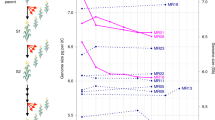Summary
X-irradiation of in vitro nodes of Dianthus ‘Mystère’ resulted in the production of useful flower colour variants at a rate of approximately 2%. The breakdown of chimeras under diplontic selection and putative selection for fitness in the mutant homohistonts was facilitated by in vitro subculture. The resultant mutants were vigorous and most were stable although pleiotropy in respect to Alternaria disease was observed.
Image analysis of leaf shape in the mutagenised progeny detected no significant differences in the population means for this character but significant increase in the standard deviation was correlated with increase in dose rate. Significant differences in means for leaf shape were detected between the control and selected flower colour-variant lines and between many of the lines indicating that the flower colour changes were occurring in a background of quantitative gene changes in the variants.
The comparative advantages of this model of in vitro mutagenesis are discussed.
Similar content being viewed by others
References
Anon., 1966. Colour chart. Royal Horticultural Society, London.
Anon., 1976. Manual of plant growth stages and disease assessment keys. Agricultural Development and Advisory Service, Harpenden.
Balkeman G.H., 1972. Diplontic drift in chimeric plants. Radiation Bot. 12: 51–55.
Broertjes C., 1977. Induced mutant techniques in breeding asexually propagated plants. p. 159–166. In: Manual on Mutation Breeding (2nd Edition). International Atomic Energy Agency, Vienna.
Broertjes C., B. Haccius & S. Weidlich, 1968. Adventitious bud formation on isolated leaves and its significance for mutaton breeding. Euphytica 17: 321–344.
Broertjes C. & A.M. van Harten, 1978. Application of mutation breeding methods in the improvement of vegetatively propagated crops. Elsevier, Amsterdam, p. 316.
Cassells, A.C., 1985. Genetic, epigenetic and non-genetic variation in tissue culture derived plants. p. 111–120. In: A. Schafer-Menuhr (Ed). In Vitro Techniques, Propagation and Longterm Storage. Martinus-Nijhoff/Dr. W. Junk.
Cassells A.C., 1992. Screening for pathogens and contaminating micro-organisms in micropropagation. p. 179–192. In: J.M. Duncan & L. Torrance (Eds). Techniques for Rapid Detection and Diagnosis. Blackwell, Oxford.
Cassells A.C. & G. Minas, 1983. Plant and in vitro factors influencing the micropropagation of Pelargonium cultivars by budtip cultures. Scientia Hortic. 21: 53–65.
Cassells A.C., S. Austin & E.M. Goetz, 1987. Variation in single cell derived clones of potato. p. 375–391. In: Y.P.S. Bajaj (Ed). Biotechnology in Agriculture and Forestry. Vol. 3. Springer-Verlag, Heidelberg.
Cassells A.C., M.L. Deadman, C.A. Brown & E. Griffin, 1991. Field resistance to late blight (Phytophthora infestans (Mont.) De Bary) in potato (Solanum tuberosum L.) somaclones associated with instability and pleiotropic effects. Euphytica 56: 75–80.
Cassells, A.C., G. Farrell & E.M. Goetz, 1986. Variation in the tissue culture progeny of the chimeral potato (Solanum tuberosum L.) variety Golden Wonder. p. 201–212. In: J. Semal (Ed). Somaclonal Variations and Crop Improvement. Martinus-Nijhoff/Dr. W. Junk.
De Klerk G-J., 1990. How to measure somaclonal variation: A review. Acta Bot. Neerld. 39: 129–144.
De Klerk G-J., J. Ter Brugge & H. Bouman, 1990. An assay to measure the extent of variation in micropropagated plants of Begonia × hiemalis. Acta Bot. Neerl. 39: 145–151.
George E.F. & P.D. Sherrington, 1984. Plant propagation by tissue culture. Exegetics, Basingstoke.
Heywood, V.H., 1978. Flowering plants of the world. Oxford University Press p. 67–69.
Karp A., 1991. On the current understanding of somaclonal variation. Oxford Surveys of Plant Molecular and Cell Biology 7: 1–58.
Leshem B., 1990. Somaclonal variation in carnations. p. 573–585. In: Y.P.S. Bajaj (Ed). Biotechnology in Agriculture and Forestry. 11. Springer-Verlag, Berlin.
Medford J.I., 1992. Vegetative apical meristems. The Plant Cell 4: 1029–1039.
Mii., M., Buiatti, M. & F. Gimelli, 1990. Carnation. p. 284–318. In: Handbook of Plant Cell Culture. Vol. 5.
Murashige T. & F. Skoog, 1962. A revised medium for rapid growth and bioassay with tobacco tissue cultures. Physiol. Plant 15: 473–497.
Noordham D., 1973. Identification of plant viruses: Methods and experiments. PUDOC, Wageningen.
Novak F.J., 1990. Plant tissue culture techniques for mutation breeding—a training manual. International Atomic Energy Agency. Vienna, p. 182.
Sanford J.C., N.F. Weeden & Y.S. Chyi, 1984. Regarding the novelty and breeding value of protoplast-derived variants of Russet-Burbank (Solanum tuberosum L.). Euphytica 33: 709–715.
Silvy A. & Y. Mitteau, 1986. Diversification des variétés d'oeillet par traitement mutagène. p. 395–405. In: Nuclear Techniques and in Vitro Culture for Plant Improvement. International Atomic Energy Agency, Vienna.
Simard M-H., N. Michaux-Ferriere & A. Silvy, 1992. Variants of carnation (Dianthus caryophyllus L.) obtained by organogenesis from irradiated petals. Plant Cell, Tissue and Organ Culture 29: 37–42.
Sonnino A., G. Ancora & C. Locardi, 1986. p. 385–394. In: Nuclear Techniques and in Vitro Culture for Plant Improvement. International Atomic Energy Agency, Vienna.
Strider D.L., 1978. Alternaria blight of carnation in the green-house and its control. Plant Dis. Rep. 62: 24–28.
Tilney-Bassett R.A.E., 1986. Plant chimeras. Arnold, London, p. 199.
Wenzel G., 1980. The potential and limits of classical genetics in plant breeding. p. 33–47. In: F. Sala (Ed). Plant Cell Cultures: Results and perspectives. Elsevier, Amsterdam.
Yu S-H, H-W. Hang, H-B. Lee & H.G. Kim, 1989. Occurrence of Alternaria dianthi on carnation in Korea. Kor. J. Mycol. 17: 229–232.
Author information
Authors and Affiliations
Rights and permissions
About this article
Cite this article
Cassells, A.C., Walsh, C. & Periappuram, C. Diplontic selection as a positive factor in determining the fitness of mutants of Dianthus ‘Mystère’ derived from x-irradiation of nodes in in vitro culture. Euphytica 70, 167–174 (1993). https://doi.org/10.1007/BF00023756
Received:
Accepted:
Issue Date:
DOI: https://doi.org/10.1007/BF00023756




